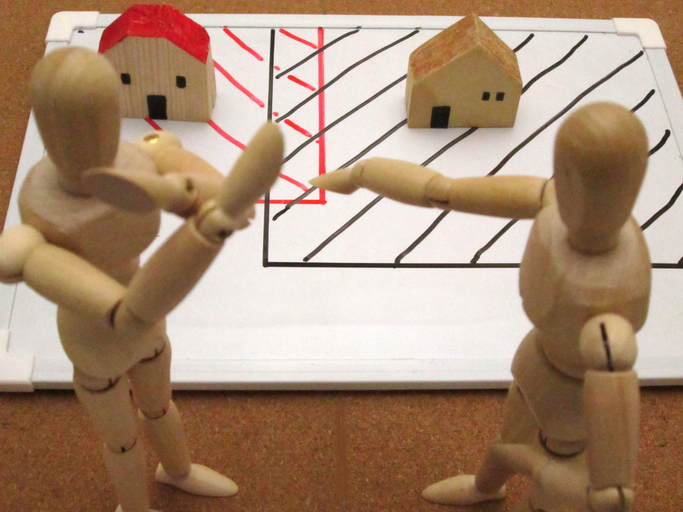A Short Guide on How to Handle a Boundary Dispute
Every parcel of land in England and Wales has a legal boundary, a conceptual dividing line that separates that parcel from its neighbours. It is established law that the position of the legal boundary will depend on the terms of the relevant deed and its plan. If, as it often is, the plan is unclear, physical boundary features will often be referred to.
This means that there can be a lot of uncertainty as to where the legal boundary lies. Physical features may have been moved from their original location or, in some cases, placed incorrectly in the first instance. Occasionally, fencing or other features (commonly stock proof fencing) are mistakenly taken as showing the location of the legal boundary.
An added complication is that, unless a boundary has been agreed or demarcated, the Land Registry plans will, in their words, “reflect what they conclude to be a reasonable interpretation of the land” as shown in its deeds. The Land Registry’s reasonable interpretation is shown by a red line around the land on the title plan attached to a property’s register. There is no standard measurement of the position of the Land Registry’s red line, or “general boundary”, in comparison to the legal boundary. This is known as the “general boundary rule” and often leads to further confusion.
Boundary disputes often arise as a result of discrepancies between the boundary features and the general boundary. These disputes often lead to neighbours falling out with each other and lots of money being spent. It is therefore important to know what steps you should take should you be involved in such a dispute.
What should I do in the first instance?
It is always better to resolve these issues amicably with your neighbour. In any event, talking to your neighbour will reveal where they believe the boundary to be and on what evidence this belief is based. Your discussions can be aided by using any deeds or title plans which you have access to as this might aid an agreement (despite the limitations of these plans as mentioned above).
If an agreement can be reached, it may be sensible to record this is in a formal document. A boundary agreement can be made demarcating the boundary where the relevant plans are insufficiently clear. In more extreme cases, a transfer of land may be a more effective way of achieving the agreement reached. If you are able to reach an agreement with your neighbour through these discussions, this would obviously be the most cost-effective resolution and it will help to maintain any neighbourly relations.
What happens if we cannot agree the boundary’s position?
If you are unable to agree upon the boundary line with your neighbour and the matter becomes a dispute, you should always check whether you have legal expenses insurance cover for boundary issues. This can be part of buildings and home contents insurance policy. If you are covered, you should contact your insurer to see if they can assist with the dispute.
Where you are not covered, you may wish to contact a solicitor to instruct them to assist with your matter.
Your solicitor may recommend that you instruct an expert boundary surveyor to produce a report and plan detailing where they understand the legal boundary to be located and why. The reason for doing so is that, should the matter progress to a final Court hearing, a Judge will rely on such expert evidence to make a determination. As a result, an early report can often prevent a dispute, and associated costs, escalating further especially if the parties’ respective surveyors are able to agree the line of the boundary.
Before thinking about commencing Court proceedings it is recommended that Alternative Dispute Resolution is considered. There are a wide range of avenues which could be used to help resolve the dispute and these will often be more cost effective than Court proceedings. One effective way of resolving a dispute is for the parties to agree to instructing an expert boundary surveyor on joint basis and agreeing to be bound by the surveyor’s determination. This process often helps to bypass the emotional element of the dispute as it focuses on the evidence on the ground rather than the actions of each party. Mediation is another useful way of getting the parties to discuss the matter with each other and think about potential solutions rather than focusing on any perceived injustices.
These matters are often emotive and parties can become entrenched. Where one party instructs an expert, the other may instruct their own with a differing opinion. In these instances, you may have to consider issuing Court proceedings for a declaration as to where the legal boundary is located. These proceedings are often costly, complex and will inevitably sour relations with your neighbour.
Court proceedings should be seen as a last resort. Although expert evidence will hold the most weight, the Judge will also consider your witness evidence and that of your neighbour so you should be prepared to make a statement and to be cross examined. As with all litigation, there is the inherent risk to the parties that they are unsuccessful and, therefore, at risk of contributing towards their neighbour’s costs (as well as their own).
The Property Litigation team at FSP have a great wealth of experience in advising clients on boundary disputes. If you would like any further information in relation to the above article or assistance with your boundary dispute, please do get in contact with the Property Litigation team.

